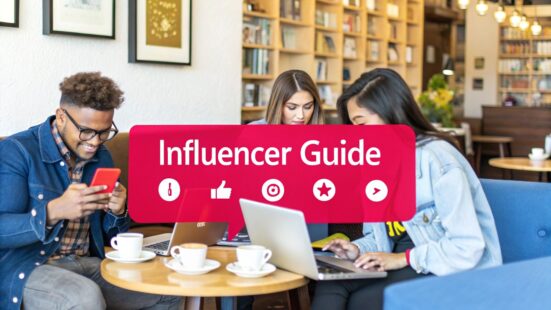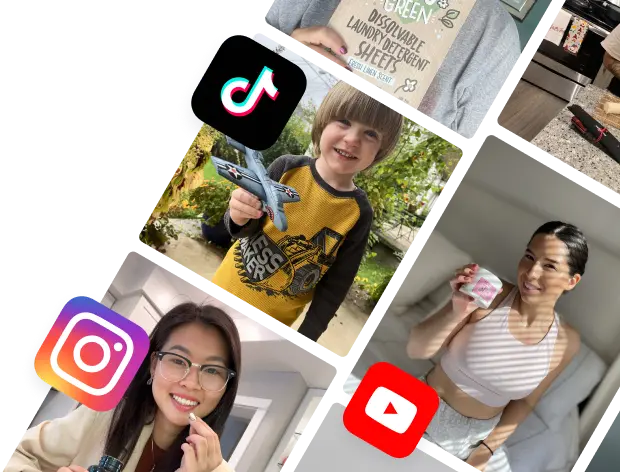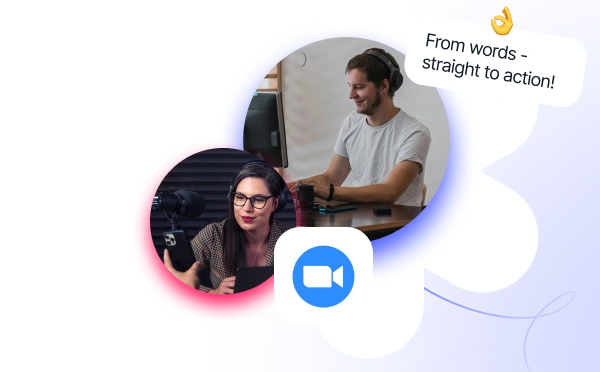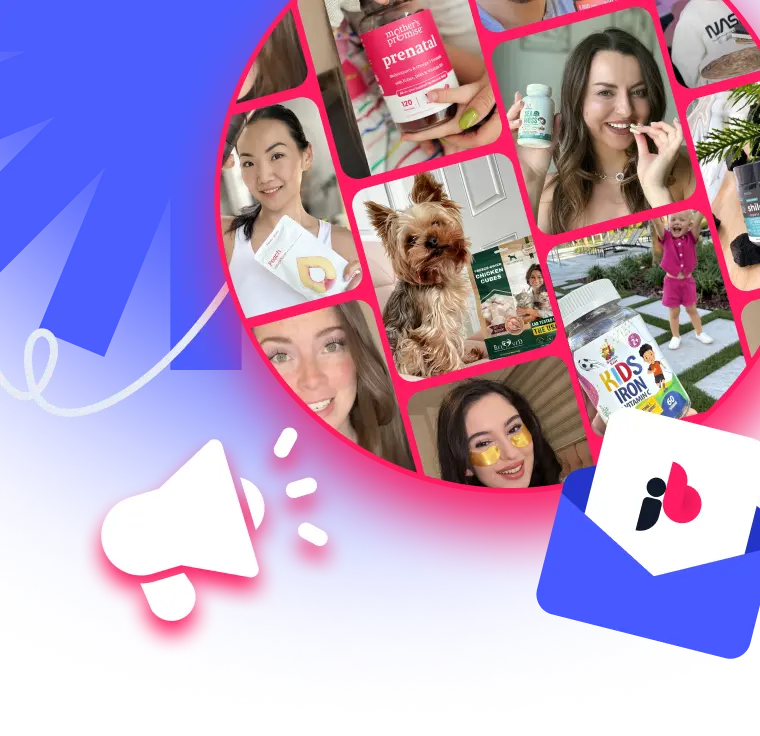 influencer marketing example: 10 standout campaigns
influencer marketing example: 10 standout campaigns
An influencer isn't just a digital billboard anymore. They're community leaders who have built incredible trust and established themselves as go-to experts in a specific niche. This deep, authentic connection makes their recommendations feel less like an ad and more like advice from a trusted friend.
Table of Contents
What Exactly Is a Modern Influencer?
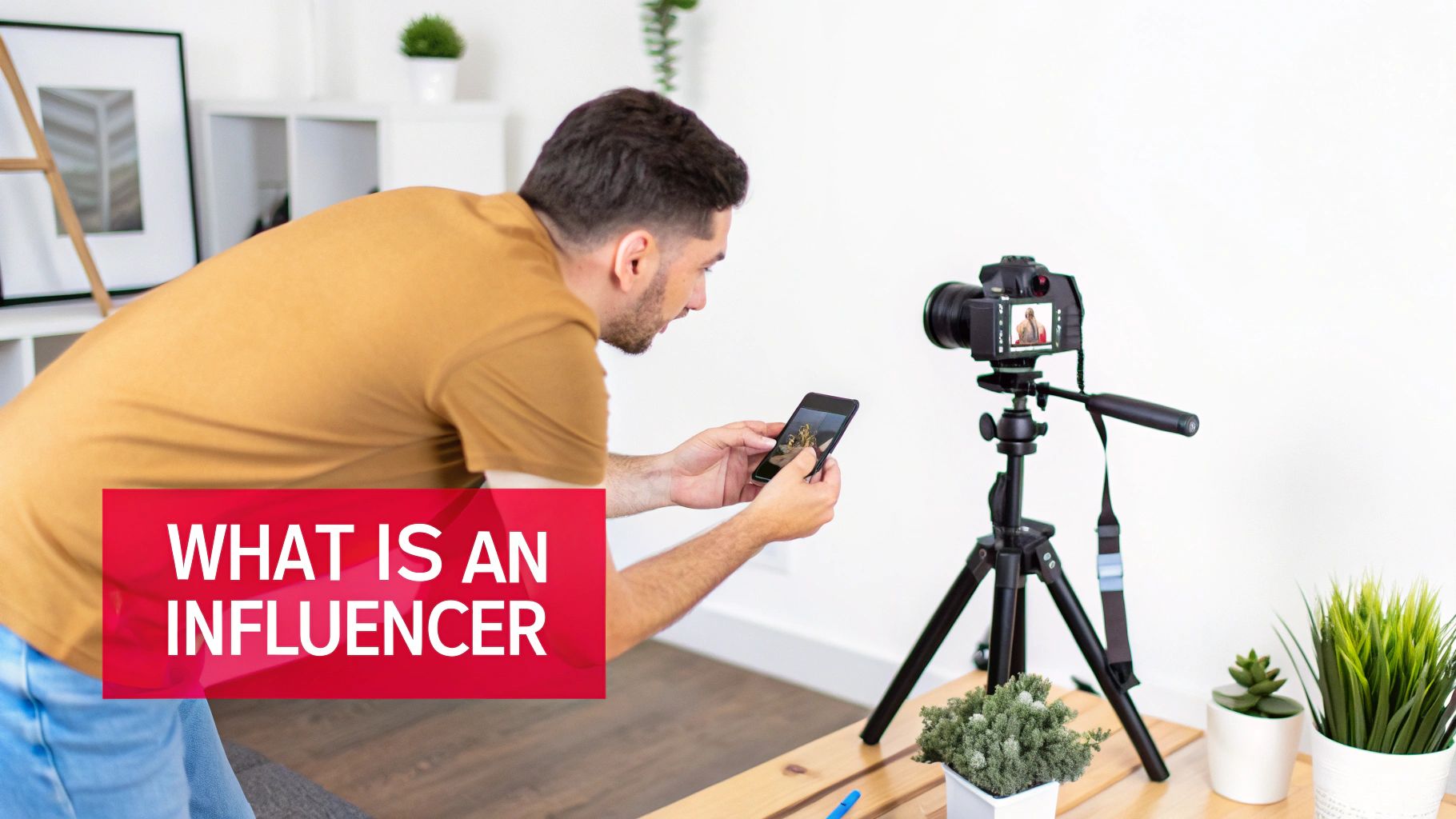
It's time to ditch the old picture of a celebrity awkwardly holding up a product for a photo. Today's influencer is playing a completely different game.
Think of it this way: you could use a generic travel brochure that just lists the most obvious tourist traps. Or, you could have a trusted local guide who knows the city inside and out—the hidden gems, the best food, the real culture. That guide's value comes from their passion and firsthand experience, and that's precisely how a modern creator builds their authority.
This fundamental shift has completely changed marketing. A great influencer doesn’t just show off a product; they weave it into compelling stories that speak directly to what their audience actually cares about. Their real power isn't measured in follower counts, but in the strength of the relationships they've built.
The Foundation of Authentic Influence
At its heart, an influencer's value comes down to one thing: genuine trust. They earn this by consistently showing up and providing real value, whether that’s through entertaining content, helpful tutorials, or just raw, honest inspiration. This consistent effort is what turns a casual follower into a die-hard community member.
Before we dive deeper, let's break down the core traits that define a successful modern influencer. These attributes go far beyond just having a lot of followers.
Key Attributes of a Modern Influencer
| Attribute | Description |
|---|---|
| Niche Expertise | They have a deep, almost obsessive, knowledge in a specific field, like sustainable fashion, vegan cooking, or personal finance for millennials. This focus makes their content credible and highly relevant. |
| Relatability | They connect on a human level by sharing personal stories, including their struggles and successes. This transparency makes their audience feel seen and understood. |
| Authenticity | They have a genuine voice and aren't afraid to be themselves. Their recommendations feel real because they are rooted in personal experience, not a script. |
| Consistent Value | They show up regularly with content that educates, entertains, or inspires. This reliability is what keeps their community coming back for more. |
These pillars of authority are what make their content so compelling. A huge part of this is their visual storytelling on platforms like Instagram, where a well-curated feed acts as their digital storefront. Finding creative Instagram feed ideas isn't just for looks; it's a critical piece of their engagement strategy.
From Follower Counts to Real Connections
The industry has wisely moved beyond vanity metrics. A massive follower list might offer broad reach, but the real magic is in the engagement—the likes, comments, shares, and DMs that prove an audience is not just watching, but actively participating.
The most effective influencer isn't a broadcaster; they're a conversation starter. They don't just talk at their audience; they talk with them. This two-way dialogue is what builds an unshakeable sense of community and loyalty.
This evolution from broadcasting to community-building is precisely why the influencer marketing space is exploding. The global market is on track to hit an incredible $32.55 billion in 2025. This isn't just a trend; it's a seismic shift in marketing, with over 80% of marketers now calling it a highly effective strategy. This focus on genuine connection is the key to understanding the profound impact influencers can have.
Understanding the Different Tiers of Influence
The word "influencer" gets thrown around a lot, but it's not a one-size-fits-all job description. The creator world is a rich ecosystem, filled with different types of influencers who each bring something unique to the table. The first step to finding the right partner for your brand is to stop thinking about a single "influencer" type and start thinking in terms of audience size—from a tight-knit group of a few thousand to a massive following in the millions.
Think of it this way: you wouldn't bring a sledgehammer to hang a small picture frame. In the same way, you wouldn't hire a celebrity with ten million followers for a product launch in a tiny, hyper-specific niche. It's all about matching the tool to the job. Getting a handle on the trade-offs between an influencer's reach, their audience engagement, the cost of a partnership, and their authenticity is absolutely fundamental.
This framework helps you look past simple follower counts and see the real strategic value hiding in each tier.
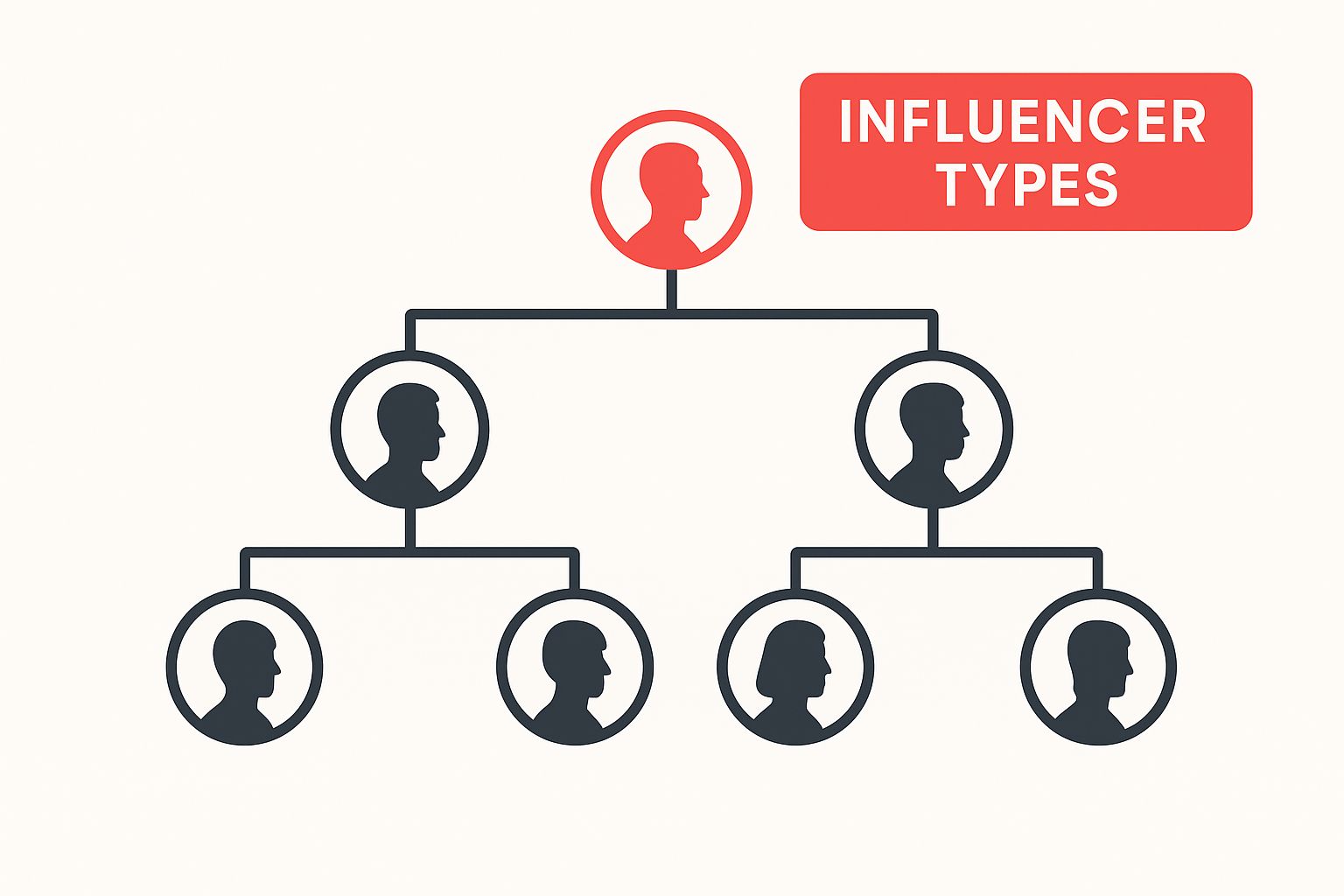
As you can see, influence is layered. Each tier serves a different function, from generating broad awareness at the top to building deep, unshakable community trust at the bottom.
Nano and Micro-Influencers: The Engagement Powerhouses
At the grassroots level, you'll find the most relatable and often most trusted creators.
Nano-influencers (1,000–10,000 followers) are your everyday people with a passion. They feel like trusted friends because, in many cases, they have personal connections with a huge chunk of their audience. This closeness translates into sky-high engagement rates and incredible trust. For brands targeting a specific local community or a niche hobby, nanos can deliver an unbelievable return.
Micro-influencers (10,000–100,000 followers) take that foundation and build on it. They operate with a larger audience but still maintain that "trusted peer" status. They're seen as genuine experts in their fields, and their recommendations carry serious weight because they've held onto the authenticity that grew their following in the first place.
These smaller creators have become the bedrock of so many successful marketing strategies. In fact, the industry has seen a massive shift towards these creators. A staggering 73% of brand partnerships now go to micro and mid-tier influencers, all thanks to their powerful engagement-to-cost ratio. You can dive deeper into this and other fascinating trends in the full Influencer Marketing Benchmark Report.
Mid-Tier Influencers: The Best of Both Worlds
Sitting right in that sweet spot between niche authority and major reach are the mid-tier influencers (100,000–500,000 followers). These are established creators who have built a real presence and often produce content with a professional polish. They manage to blend the relatability of a micro-influencer with the audience size needed for a serious awareness push.
For brands ready to scale their efforts, mid-tier partners offer a perfectly balanced approach. They can drive both meaningful conversations and impressive reach, all without the celebrity-level price tag that comes with bigger names. They're the go-to choice for campaigns that need to make a real splash with a large, yet still targeted, audience.
Choosing an influencer is all about matching your campaign goal to the creator's core strength. Need to build deep trust in a niche community? Go micro. Need to drive widespread awareness for a new product launch? Macro might be your answer.
Macro and Mega-Influencers: The Reach Machines
Finally, at the very top of the pyramid, we have the creators with truly massive audiences.
Macro-Influencers (500,000–1,000,000 followers): These are your well-known internet personalities, digital-native stars, or top experts who have achieved a level of fame within their specific vertical. They are perfect for large-scale awareness campaigns designed to introduce a brand or product to hundreds of thousands of people almost instantly.
Mega-Influencers (1,000,000+ followers): This is the realm of celebrities, pro athletes, and the absolute biggest names in the digital space. Partnering with a mega-influencer is less about deep engagement and all about mass-market visibility. One single post can put your brand in front of millions, making them a powerful—though expensive—choice for global brands that need maximum exposure.
While their engagement rates might be lower as a percentage, the sheer volume of eyeballs they command is immense. Picking the right influencer tier is the first, and most critical, decision you'll make when building out your campaign.
The Real Reasons Brands Partner with Influencers

From the outside, the billions pouring into the influencer economy can seem a bit strange. Why would a major brand pay someone to post on social media when they could just buy traditional ads? It's a fair question, but the answer cuts to the very heart of modern marketing: an influencer delivers critical value that old-school advertising simply can't match.
This isn’t just about getting in front of new people. It's about connecting with them in a way that feels real and trustworthy. When an influencer recommends a product, it doesn't land like a polished ad script. It feels more like a genuine tip from a knowledgeable friend, creating a powerful ripple effect that drives real business.
Generating Authentic Social Proof
One of the biggest reasons brands work with influencers is to generate social proof. This is just a fancy term for the simple fact that we tend to follow the actions of others, especially people we trust. A traditional ad shouts, "Our product is great." An influencer says, "I actually use and love this product."
The difference is massive. When a tech creator posts an in-depth video review of a new laptop, they're doing more than just rattling off specs. They’re showing it in action, integrating it into their daily life, and building a genuine case for its value. That kind of third-party validation is infinitely more persuasive than a brand singing its own praises.
In a market flooded with options, authenticity is the ultimate currency. An influencer partnership lets a brand "borrow" the trust a creator has spent years, sometimes decades, building with their community. That borrowed trust is often the final nudge someone needs to make a purchase.
At its core, this approach taps directly into our human nature. We're wired to trust recommendations from people we know and respect far more than faceless corporate messages.
Creating a Stream of High-Quality Content
Smart brands don't just see a one-off sponsored post; they see a content creation engine. Think about it: hiring a professional crew for a photoshoot or video production is a logistical nightmare—it’s slow and incredibly expensive. An influencer, on the other hand, is a one-person production house.
These creators are masters of their craft, producing content that is not only high-quality but also perfectly tailored for the platform it lives on. The stuff they create feels inherently authentic and relatable, which is often called user-generated content (UGC).
Brands can then take this goldmine of content and repurpose it across their own marketing channels:
- Ad Creatives: Use influencer-made videos and images to run paid social ads that don’t feel like ads.
- Website Content: Feature influencer photos on product pages to show items in a real-world, relatable context.
- Social Media Feeds: Repost creator content to fill their own feed with authentic material that resonates.
For example, a fashion brand can see its sales spike after an influencer showcases an outfit in an authentic 'get ready with me' video. The brand gets an immediate sales bump and a fantastic video asset it can use for weeks or even months.
Driving Highly Targeted Traffic That Converts
Finally, an influencer gives a brand a direct pipeline to a laser-focused audience. A company selling specialized hiking gear doesn't need to reach everyone on the internet; it just needs to reach people who are genuinely passionate about hiking. Partnering with an outdoors and adventure influencer is the most efficient way to make that happen.
These creators have already done the heavy lifting of building a loyal community around a specific niche. So, when they share a link or a discount code, they're sending warm, qualified leads straight to the brand’s website.
Here’s how that translates into real, tangible results:
- Increased Click-Through Rates: An influencer's followers are far more likely to click a link because it comes with a trusted endorsement.
- Higher Conversion Rates: The traffic that lands on the site is already pre-qualified and interested in the product category, making them much more likely to buy.
- Measurable ROI: Using unique discount codes and affiliate links allows brands to track sales directly back to a specific influencer, giving them crystal-clear data on how the campaign is performing.
When you put it all together, partnering with the right influencer isn't just one strategy—it's three. It’s a tool for building deep trust, a factory for authentic content, and a precision-guided method for driving sales.
How to Find and Vet the Right Influents
Finding the perfect influencer to partner with is a lot like casting the lead role in a blockbuster movie. You need someone who not only looks the part but can genuinely connect with the audience and deliver a convincing performance. This process is a careful mix of smart searching and data-driven homework to make sure you land a creator who is a true match for your brand.
The first move is to think beyond follower counts and build your ideal creator persona. Who is this person, really? What are they passionate about? What’s their content style, and what kind of community have they nurtured? Focus less on the numbers and more on their specific niche, tone, and visual aesthetic. A clear persona will be your North Star, guiding your entire search.
Once you know exactly who you're looking for, it's time to start the hunt.
Building Your Candidate List
Your goal here is to cast a wide net and find potential partners who line up with your persona. You shouldn't stick to just one method; use a combination of approaches to build a solid list of candidates who could be a fantastic fit for your brand.
Here are the most effective ways to find an influencer:
- Influencer Marketing Platforms: This is what tools like JoinBrands were built for. They let you sift through massive databases of creators using filters for niche, audience demographics, platform, and engagement rates, which really speeds up the discovery phase.
- Targeted Social Media Searches: Go straight to the source. Use relevant hashtags and keywords on Instagram, TikTok, and YouTube to see who’s already making popular content in your space.
- Competitor Analysis: Check out who your competitors are working with. This not only points you to potential partners but also gives you a peek into what kinds of collaborations are already clicking with your shared target audience.
If you’re trying to find and vet the right influencers, getting to know the specific features and marketplaces on each platform is a huge advantage. For example, getting familiar with the TikTok Creator Marketplace requirements can help you tap into one of the most dynamic creator ecosystems out there today.
The Critical Vetting Process
Once you have a list of candidates, the real work begins. Vetting is where you separate the authentic creators from those with puffed-up numbers or values that don't align with yours. It’s all about looking past the surface-level stats and digging into the data that actually drives results for your brand.
Zero in on these key metrics:
- Authentic Engagement Rate: Don't get distracted by likes. Dive into the comments. Are they generic junk like "Nice post!" or are they real, thoughtful conversations? A healthy comment section is a dead giveaway of a truly engaged community.
- Audience Demographics: An influencer's audience has to be your audience. Ask for a screenshot of their audience analytics to double-check their followers' age, gender, location, and interests. If there's a mismatch here, your message will just fall on deaf ears.
- Content Quality and Consistency: Do a deep dive on their last 10-20 posts. Is the quality consistently high? Does their style fit with your brand's look and feel? Pay attention to how they handle other sponsored posts—does it feel natural or like a clumsy, forced ad?
The Red Flag Checklist: A big follower count can easily mask some serious issues. Keep an eye out for sudden, weird spikes in followers, a comment section flooded with spam or bots, and any history of controversial or brand-damaging posts. A single red flag should be your cue to investigate much deeper before you even think about committing.
This tough vetting process ensures you partner with a creator who can actually deliver real results. The industry is moving more and more toward these deeper connections. Brands aren't just investing more; they're also focusing on long-term partnerships (which lead 47% of campaigns) and using AI tools to get more personal. You can dig into this and other major trends in the latest influencer marketing report.
At the end of the day, a great partnership is all about alignment. By carefully identifying and vetting every potential influencer, you protect your investment and set the stage for a collaboration that feels authentic to the audience and drives real, measurable growth for your business.
How to Build and Scale Influencer Campaigns
Jumping from a one-off influencer collaboration to a full-scale, always-on program is a huge leap. It's the difference between a single transaction and building a real, strategic asset for your brand. To pull this off, you need a repeatable system for everything—from how you say hello to how you track results.
The goal isn't just to run a project; it's to build an engine. An engine fueled by genuine relationships, clear creative goals, and the right tech to keep it all humming.
Crafting the Perfect Outreach and Creative Brief
Your very first message sets the stage for the entire partnership. A generic, copy-paste email is the quickest way to land in a quality influencer’s trash folder. Your outreach has to be personal. It needs to show you’ve actually watched their content, you get their vibe, and you understand their audience.
Once you've made that initial connection, the creative brief becomes your playbook. This is where the real art lies. You have to give enough direction so your brand's message comes through clearly, but not so much that you kill the creator's spark. A good brief doesn't hand them a script; it gives them a sandbox to play in.
A solid creative brief should cover:
- Campaign Goals: Are you chasing brand awareness, clicks to your site, or actual sales? Be crystal clear.
- Key Talking Points: Give them two or three must-have messages about your product, but let them deliver those points in their own words.
- Content Do's and Don'ts: Lay out any brand safety no-gos or visual needs, but don't micromanage their creative process.
- Call to Action: Tell them exactly what you want the audience to do. Use a code? Click a link? Visit a specific page?
This approach treats the influencer like a true creative partner, not just a hired megaphone. And what you get in return is content that feels real, hits home with their audience, and ultimately, performs a whole lot better.
Building Long-Term, Authentic Relationships
The most impactful influencer programs aren't just about the money. They're built on real, lasting relationships. One-off campaigns can feel cheap and transactional, but long-term partnerships let an influencer truly weave your brand into their story.
When a creator shows off your product over several months or even years, their audience starts to see it as a genuine part of their world. That kind of sustained exposure builds a level of trust and credibility that a single sponsored post could never dream of achieving.
Shifting from short-term tactics to long-term partnerships transforms an influencer from a simple promoter into a genuine brand ambassador. This is the difference between renting their audience and earning their loyalty.
This relationship-first mindset breeds authenticity and drives far better results. It signals that you value the creator for their unique voice and the community they've built, not just their follower count. The data backs this up, showing a clear pivot from chasing viral fads to seeking measurable ROI. In fact, 47% of marketers are set to boost their influencer budgets by 11% or more in 2025. You can dive deeper into these trends by checking out the full report on the future of influencer marketing.
Using Technology to Streamline and Scale
Juggling relationships with a few creators is manageable. But trying to scale that to dozens—or hundreds—is a recipe for chaos without the right tools. This is where dedicated influencer marketing platforms like JoinBrands become absolutely essential.
Technology takes care of the tedious, manual tasks that can completely derail a growing program. Think of it as the central command center for your entire influencer world.
These platforms are game-changers for managing key workflows:
- Centralized Communication: No more digging through emails and DMs. All your conversations, negotiations, and content approvals live in one organized spot.
- Automated Product Seeding: Sending products out to creators becomes a breeze. You can easily ship, track deliveries, and make sure everyone has what they need to start creating.
- Simplified Payments: Forget messy invoicing. Handle payments to creators all over the world efficiently and securely.
- Performance Tracking: See how everything is performing from a single dashboard. You can monitor key metrics across all your campaigns and creators, making it simple to spot what’s working and double down on it.
By automating the administrative grind, you free up your team to focus on what really moves the needle: nurturing strong relationships and brainstorming creative, high-impact campaigns. That blend of human connection and smart technology is the secret to building an influencer program that’s ready to grow with your brand.
If you can't measure it, you can't improve it. This old saying is especially true in influencer marketing. It's easy to get distracted by "vanity metrics" like likes and comments, but true impact isn't measured in applause. It's measured in tangible results that trace directly back to your business goals.
Think of it like this: your campaign is a road trip. The influencer is your awesome, souped-up car. But without a map and some clear road signs—your Key Performance Indicators (KPIs)—you're just burning gas. You might be moving, but you have no idea if you're actually getting closer to your destination.
Aligning Metrics with Your Goals
The very first step is to match your measurement strategy to what you’re trying to achieve. The numbers you'd watch for a brand awareness campaign are totally different from those you'd track for a direct sales push. Your objectives dictate your data.
A solid measurement framework maps specific KPIs to each goal:
- Brand Awareness: Is your main goal just to get your name out there? Then you'll want to focus on impressions (how many times your content was seen) and reach (how many unique people saw it). These metrics tell you how far and wide your message traveled.
- Audience Engagement: To see if your content actually connected with people, you have to look deeper than likes. Track shares, saves, and comments. These are active signals that the audience found the content so valuable they had to interact with it or save it for later.
- Conversions and Sales: When the goal is to drive action, it’s all about clicks, leads, and sales. This is where you draw a straight line from an influencer's post to actual money in the bank.
Measuring an influencer campaign without the right tools is like trying to guess the temperature without a thermometer. Sure, you’ll get a general sense of whether it's hot or cold, but you won't have the precise data you need to make smart decisions and prove your success to the people who matter.
Practical Tools for Tracking Success
To get this kind of data, you need the right tracking mechanisms set up before your campaign ever goes live. These tools are the bridge connecting an influencer's content to your business results, making your return on investment (ROI) crystal clear.
Your tracking toolkit should include a few essentials:
- UTM Parameters: These are just little snippets of code you add to a URL. They don't change the destination, but they tell your analytics software exactly where every visitor came from. You can create a unique UTM for each influencer to see precisely how much traffic they drove.
- Affiliate Links: This is the next level up from UTMs. Affiliate links don't just track clicks; they track the sales that result from those clicks. It's one of the most direct ways to measure an influencer's real sales impact.
- Unique Discount Codes: Giving each influencer a specific code (like “SARAH15”) is a dead-simple but incredibly powerful way to attribute sales. Plus, it gives their audience a nice little nudge to make a purchase.
The influencer world is becoming more and more driven by data. In fact, 66.4% of marketers report seeing better campaign outcomes when they integrate AI into their strategy. As our tools get smarter, our ability to measure what truly matters gets sharper. You can dig into more trends like this in the latest influencer marketing benchmark findings.
By building a clear report with these concrete metrics, you can stop talking about "buzz" and start demonstrating the powerful, undeniable business value of your influencer program.
Alright, let's tackle those nagging questions that always pop up when you start diving into influencer partnerships. Getting a handle on these key issues from the get-go helps you sidestep common mistakes and build a strategy that actually works.
How Much Does It Cost to Hire an Influencer?
There’s really no simple price tag for influence. The cost can swing wildly depending on everything from an influencer's audience size and their specific niche to the platform they use and exactly what you’re asking them to create. A nano-influencer might be thrilled to collaborate for free products, while a mega-influencer can easily command six-figure fees for a single post.
The real trick is to shift your focus from the upfront cost to the potential value and your expected Return on Investment (ROI). Always frame your negotiations around clear deliverables—things like the number of posts, stories, and, crucially, the rights to use the amazing content they create for you.
What Is the Difference Between an Influencer and a Content Creator?
You'll hear these terms thrown around interchangeably, but there's a subtle yet important difference that's good to know.
- A content creator is all about the craft of production. They're the ones making high-quality videos, stunning photos, or beautifully written blog posts.
- An influencer, on the other hand, is valued for their ability to actually sway their audience's opinions and, when it comes down to it, their buying decisions.
Think of it this way: the best influencers are also fantastic content creators, but not every skilled creator has built the kind of trust and authority needed to have true influence. One creates assets; the other creates impact.
How Do I Write an Outreach Message That Gets a Response?
Personalization is everything. Seriously. Firing off generic, copy-and-pasted templates is the fastest way to get your message deleted and forgotten. If you want to stand out, you have to show you’ve actually done your homework.
Start by addressing the influencer by their name. Then, reference a specific piece of their recent content that you genuinely liked. Finally, briefly and clearly explain why a partnership would be a fantastic and logical fit for their audience.
Keep your message short and sweet, state your idea clearly, and be upfront about what’s in it for them—whether that's payment, free product, or some other kind of value.
Do I Need a Formal Contract?
Yes. One hundred percent, yes. A formal, written contract is completely non-negotiable. It’s your safety net, protecting both your brand and the influencer from any misunderstandings that might crop up later.
Your agreement should spell out all the critical parts of the deal. We’re talking about all deliverables, specific timelines and deadlines, payment terms, who owns the content and how you can use it, any exclusivity clauses, and the mandatory FTC disclosure rules for sponsored posts. Even for a small, product-only collaboration, a simple agreement keeps everyone on the same page and accountable.
Ready to streamline your campaigns and connect with the perfect creators? JoinBrands is your all-in-one platform for finding, managing, and scaling your influencer marketing efforts. Start your campaign today and amplify your brand with over 250,000 vetted creators.
